Simulation of the Gas Distribution Law and Operational Risk Analysis of a Vertical Gas Tank in a Ventilation State
Abstract
:1. Introduction
2. Simulation of Basic Assumptions and Establishment of Governing Equations
2.1. Basic Assumption
- (1)
- The internal structure of a gas tank in an actual working environment is complex. Therefore, it was necessary to simplify the geometric model used for the FLUENT simulation according to the data measured by different gas tanks. In other structures in gas tanks close to a wall, the influence of gas and wind flows in the tank was ignored to facilitate the calculation.
- (2)
- Storage tanks can be divided into three types, according to their external shape characteristics: vertical cylindrical storage tanks, with the circumferential surface of the tank body perpendicular to the ground; horizontal cylindrical storage tanks, with the central axis parallel to the ground; and tanks with a noncylindrical surface. Vertical cylindrical storage tanks are the most common in engineering [26]. Therefore, vertical tanks with different diameters were selected as the simulation objects. The specific dimensions and ventilation conditions are shown in Table 1. The air composition of natural ventilation is mainly oxygen and nitrogen. Therefore, the components of the external airflow were composed of oxygen and nitrogen. The oxygen concentration used was 21% and the nitrogen concentration was 79%. The content of other gases is very small; thus, they were ignored. The gas flow in a tank may be regarded as an incompressible fluid, and there is no chemical reaction of the gas in the tank; that is, the flow field space is regarded as an unsteady single-phase problem without a chemical reaction.
2.2. Governing Equation Establishment
- (1)
- Mass Conservation Equation
- (2)
- Momentum conservation equation
- (3)
- Component mass conservation equation
- (4)
- Energy conservation equation
3. Mesh Model and Boundary Conditions
4. Simulation Results and Analysis
4.1. Simulation Results of Gas Migration in a Vertical, Single-Manhole, 2.6 m-Diameter Gas Tank
4.2. Simulation Results of Gas Migration in a Vertical, Single-Manhole, 5.2 m-Diameter Gas Tank
4.3. Simulation Results of Gas Migration in a Vertical, Single-Manhole, 7.8 m-Diameter Gas Tank
5. Risk Analysis of Gas Tank Operation
5.1. Theoretical Prediction Analysis
5.2. Theoretical Prediction Analysis
6. Discussion
7. Conclusions
- (1)
- We simulated gas tanks with tank diameters of 2.6 m, 5.2 m, and 7.8 m. The larger the diameter, the longer the required ventilation time. According to the simulation, the tank diameter of 2.6 m required ventilation for at least 6 h, the tank diameter of 5.2 m required ventilation for at least 24 h, and the tank diameter of 7.8 m required ventilation for at least 80 h. Therefore, gas concentration monitoring is required and work can commence after monitoring reaches the required standard.
- (2)
- The simulation results were compared with theoretical formula calculations and experimental test results. According to the calculation results, the hourly CO2 gas exchange was 7%. According to the simulation results, when the tank diameter was 2.6 m, the exchange rate per hour was approximately 3%, slightly decreasing with the increase in simulation time. When the tank diameter was 5.2 m, the exchange rate per hour was approximately 2.5%, slightly decreasing with the increase in simulation time. When the diameter of the tank was 7.8 m, the exchange rate per hour was approximately 1%, slightly decreasing with the increase in simulation time. The variation trend of the simulated value was the same as that of the theoretical value and the experimental test value. The measured value of the ventilation duration was greater than the theoretical value of the ventilation duration and this was greater than the simulated value of the ventilation duration. The larger the tank diameter, the longer the required ventilation time.
- (3)
- To ensure the safety of the working environment and the operators, a certain number of monitoring points are required for poorly ventilated gas tanks. According to the simulation results, at least one monitoring point should be set at the upper and lower ends of the gas tank, respectively, for a vertical tank. The monitoring results of the upper end and the lower end should all be verified, indicating that the overall ventilation of the gas tank is complete and that work can commence.
Author Contributions
Funding
Data Availability Statement
Conflicts of Interest
References
- Jiang, H. Analysis of Toxic and Hazardous Substances Before Working in Confined Spaces. Res. Contemp. Chem. Ind. 2020, 119–120. [Google Scholar]
- Dai, L.; Han, Y.; Wei, R.; Wang, G.; Song, W.; Xiang, J. Design of ventilation scheme for confined spaces. China Shipbuild. 2012, 53, 520–525. [Google Scholar]
- Li, X. Ventilation method for oil tank maintenance project. Pet. Eng. Constr. 2004, 20, 13–15+3. [Google Scholar]
- Li, Q.; Pan, C.; Li, X.; Wang, C. Methane leakage simulation in confined space. J. Bengbu Univ. 2022, 11, 26–28+35. [Google Scholar]
- Tan, C.; Liu, Y.; Wang, T.; Qin, Y. Numerical simulation of ventilation and protection technology for confined space in municipal heating. J. Harbin Inst. Technol. 2017, 49, 123–128. [Google Scholar]
- Yang, X.; Li, H.; Liu, H.; Chen, S. Three-dimensional numerical simulation analysis of gas flow field distribution and optimization in single-hole pressure vessel. Energy Conserv. 2019, 38, 61–64. [Google Scholar]
- Yang, C.; Liu, Y.; Qin, Y. Research on natural ventilation characteristics and influencing factors of single-opening confined space. Saf. Environ. Eng. 2019, 26, 183–189. [Google Scholar]
- Li, G. Safety simulation analysis of hazardous gas replacement in confined space. China Public Secur. (Acad. Ed.) 2015, 50–55. [Google Scholar] [CrossRef]
- Chen, Y.; Zhong, H.; Gao, H.; Zhang, Z. Research on air distribution simulation and thermal comfort under different ventilation conditions. Sci. Technol. Innov. 2020, 28–30. [Google Scholar]
- Li, Y. Numerical Simulation of Natural Gas Leakage, Diffusion, and Explosion in Confined Space; Capital University of Economics and Business: Beijing, China, 2011. [Google Scholar]
- Wang, Z. Numerical Simulation and Analysis of Gas Diffusion in Confined Space; Dalian University of Technology: Dalian, China, 2009. [Google Scholar]
- Li, X. Safety Analysis and Preventive Measures of Storage Tank Leakage in Liquefied Gas Filling Station; Chongqing Institute of Science and Technology: Chongqing, China, 2018. [Google Scholar]
- Quan, M.; Wang, Y.; Zhou, Y.; Xu, K.; Cao, Y.; Ren, X. Effect of swirl ventilation on contaminant removal in a cylindrical confined space. Build. Environ. 2021, 205, 108277. [Google Scholar] [CrossRef]
- Pouzou, J.G.; Chris, W.; Neitzel, R.L.; Croteau, G.A.; Yost, M.G.; Seixas, N.S. Confined space ventilation by shipyard welders: Observed use and effectiveness. Ann. Occup. Hyg. 2015, 59, 116–121. [Google Scholar]
- Zhao, W.; Zhang, T.; Jia, C.; Li, X.; Wu, K.; He, M. Numerical Simulation on Natural Gas Migration and Accumulation in Sweet Spots of Tight Reservoir. J. Nat. Gas Sci. Eng. 2020, 81, 103454. [Google Scholar] [CrossRef]
- Wei, S.Y.; Chen, X.X.; Dong, L.H.; Li, Z. Numerical Simulation Research of Gas Migration Laws on Real Underground Mining Conditions. In Mechanical Engineering and Control Systems: Proceedings of 2015 International Conference on Mechanical Engineering and Control Systems (MECS2015); World Scientific: London, UK, 2016. [Google Scholar]
- Lu, Q.; Wei, X.; Maoqing, B.E. Lattice Boltzmann Simulations of Gas Migration Law in Two-Dimension Goaf of Fully Mechanized Coal Caving Mining Face. In Proceedings of the International Conference on Computer Science Education, Kaifeng, China, 25–27 July 2008. [Google Scholar]
- Schmidt, D.; Krause, U.; Schmidtchen, U. Numerical simulation of hydrogen gas releases between buildings. Int. J. Hydrogen Energy 2008, 24, 479–488. [Google Scholar] [CrossRef]
- And, S.S.; Rigas, F. Fuel Gas Dispersion under Cryogenic Release Conditions. Energy Fuels 2005, 19, 2535–2544. [Google Scholar]
- Tauseef, S.M.; Rashtchian, D.; Abbasi, S.A. CFD-based simulation of dense gas dispersion in the presence of obstacles. J. Loss Prev. Process Ind. 2011, 24, 371–376. [Google Scholar] [CrossRef]
- Wang, Y. Research on Dynamic Risk Assessment and Emergency Response of Road Transport Accidents of Dangerous Chemicals; Beijing Institute of Petrochemical Technology: Beijing, China, 2021. [Google Scholar]
- Meel, A.; O’Neill, L.M.; Levin, J.H.; Seider, W.D.; Oktem, U.; Keren, N. Operational risk assessment of chemical industries by exploiting accident databases. J. Loss Prev. Process Ind. 2007, 20, 113–127. [Google Scholar] [CrossRef]
- Paltrinieri, N.; Khan, F.; Amyotte, P.; Cozzani, V. A dynamic approach to risk management: Application to the Hoeganaes metal dust accidents. Process Saf. Environ. Prot. 2014, 92, 669–679. [Google Scholar] [CrossRef]
- Kalantarnia, M.; Khan, F.; Hawboldt, K. Modelling of BP Texas City refinery accident using dynamic risk assessment approach. Process. Saf. Environ. Prot. 2010, 88, 191–199. [Google Scholar] [CrossRef]
- Rathnayaka, S.; Khan, F.; Amyotte, P. Accident modeling approach for safety assessment in an LNG processing facility. J. Loss Prev. Process Ind. 2012, 25, 414–423. [Google Scholar] [CrossRef]
- Wu, W. Structural Analysis and Safety Evaluation of Large Vertical Storage Tanks; Liaoning University of Petrochemical Technology: Fushun, China, 2020. [Google Scholar]
- Hu, Y. Theoretical Calculation and Numerical Simulation of Single Opening Natural Ventilation Driven by Unsteady Wind Pressure; Hunan University: Changsha, China, 2013. [Google Scholar]
- Wan, Y.; Li, L.; Wang, W.; Liang, P.; Huang, Y.; Chen, Z. Research on the leakage and diffusion law of LPG storage tanks based on Fluent’s wind direction. Pet. Nat. Gas Chem. Ind. 2021, 50, 98–103. [Google Scholar]
- Gonin, R.; Hogue, P.; Guibert, R.; Fabre, D.; Bourguet, R.; Ammouri, F.; Vyazmina, E. A computational fluid dynamic study of the filling of a gaseous hydrogen tank under two contrasted scenarios. Int. J. Hydrogen Energy 2022, 47, 23278–23292. [Google Scholar]
- Tao, J.; Li, Z.; Guo, Z.; Zhang, N. Calculation of LNG leakage gas concentration and temperature diffusion process. Cryog. Supercond. 2020, 48, 12–19+25. [Google Scholar]
- Zhang, J.; Xu, C.; An, J.; Yuan, Y. Numerical simulation of heavy air leakage and diffusion in rooms under different ventilation forms. Gas Heat 2018, 38, 32–38. [Google Scholar]
- Fu, W. Simulation and Experimental Research on Large Openings for Natural Ventilation; Xi’an University of Architecture and Technology: Xi’an, China, 2008. [Google Scholar]
- Ouellette, P.; Hill, P.G. Turbulent transient gas injections. J. Fluid Eng. 2000, 122, 743e52. [Google Scholar] [CrossRef]
- Galassi, M.C.; Baraldi, D.; Acosta Iborra, B.; Moretto, P. CFD analysis of fast filling scenarios for 70 MPa hydrogen type IV tanks. Int. J. Hydrogen Energy 2012, 37, 6886e92. [Google Scholar] [CrossRef]
- Galassi, M.C.; Papanikolaou, E.; Heitsch, M.; Baraldi, D.; Iborra, B.A.; Moretto, P. Assessment of CFD models for hydrogen fast filling simulations. Int. J. Hydrogen Energy 2014, 39, 6252e60. [Google Scholar]
- Melito, D.; Baraldi, D.; Galassi, M.C.; Ortiz Cebolla, R.; Acosta Iborra, B.; Moretto, P. CFD model performance benchmark of fast filling simulations of hydrogen tanks with pre-cooling. Int. J. Hydrogen Energy 2014, 39, 4389e95. [Google Scholar]
- Zhang, S.; Hong, B.; Gao, H. Grid ruler for numerical simulation of air and underwater blast shock waves Comparative analysis of inch effect. J. Hydraul. Eng. 2015, 46, 298–306. [Google Scholar]
- Hoogendoorn, C.J.; Afgan, N. Energy Conservation in Heating, Cooling, and Ventilating Buildings: Heat and Mass Transfer Techniques; Hemisphere Publishing Corporation: London, UK, 1978. [Google Scholar]
- Zhao, T. Numerical Study of Pollutant Diffusion in Adjacent Industrial Plants under Natural Ventilation; Xi’an University of Architecture and Technology: Xi’an, China, 2021. [Google Scholar]
- Xiong, Y. The Influence of the Concave and Convex Features of High-Rise Residential Planes on Unilateral Ventilation and Pollutant Concentration; Huazhong University of Science and Technology: Wuhan, China, 2021. [Google Scholar]
- Cai, L. Optimal Design of Natural Ventilation for Intermediate Units in High-Rise Residential Buildings; China University of Mining and Technology: Xuzhou, China, 2021. [Google Scholar]
- Zhang, H.; Li, W.; He, G.; Wang, M. Research on ventilation characteristics of rooms with one side opening. Chin. Foreign Archit. 2011, 116–117. [Google Scholar]
- Zhang, F. Research on the Optimization of Gas flow and Ventilation Inside Hazardous Chemical Transportation Tank Cars; China University of Mining and Technology: Xuzhou, China, 2022. [Google Scholar]
- Yang, Y. Study on Flue Gas Flow of Natural Exhaust Vents under the Action of Environmental Wind; Central South University: Changsha, China, 2011. [Google Scholar]
- Luo, J.; Zhou, X. Study on the influence of grid element shape on calculation accuracy in numerical simulation. J. Yellow River Univ. Sci. Technol. 2022, 24, 8–11. [Google Scholar]
- Xie, Z.; Han, Y. Research on the grid-scale effect of finite element analysis of temperature field. China Water Transp. (Second. Half Mon.) 2017, 17, 204–206. [Google Scholar]
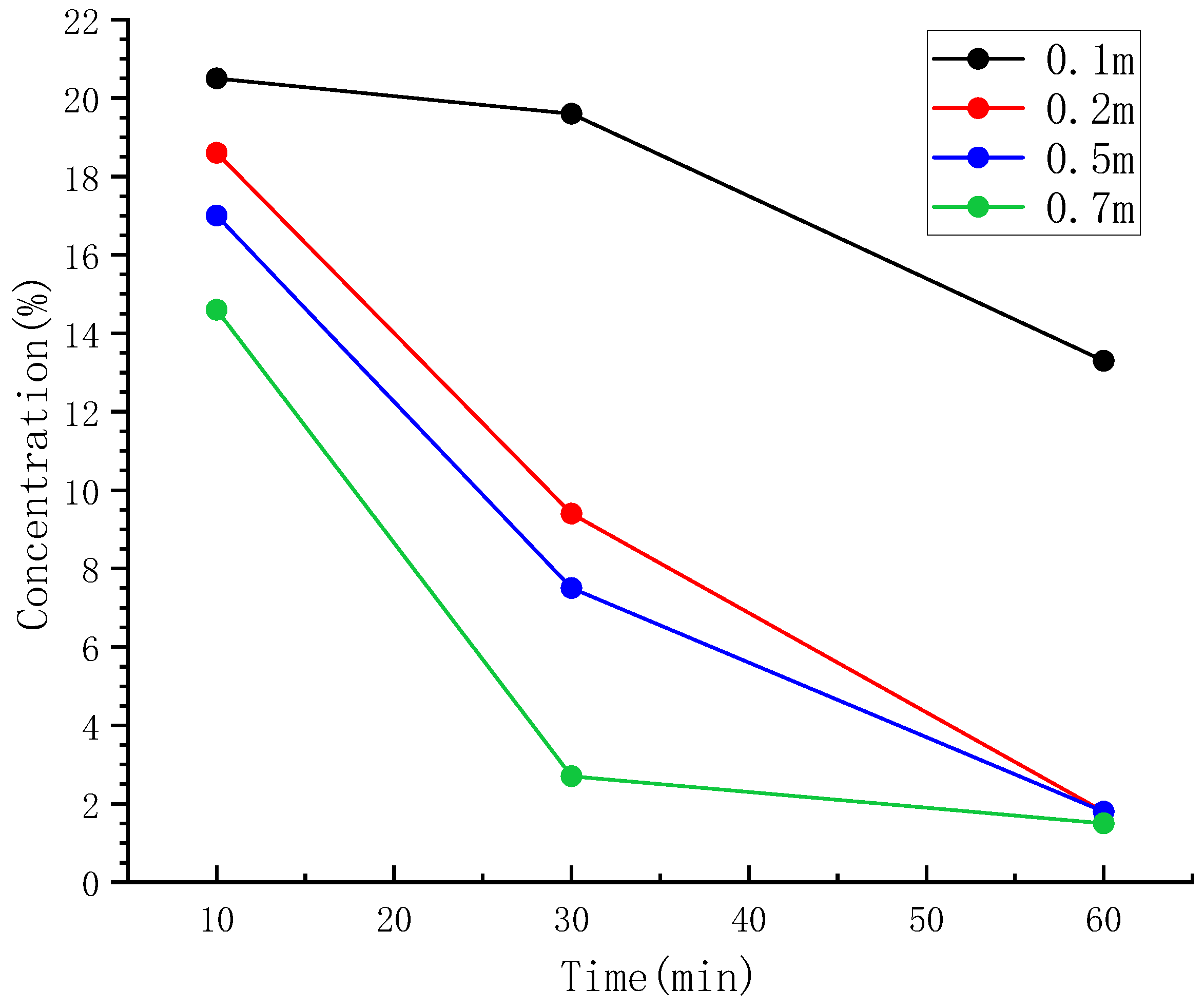



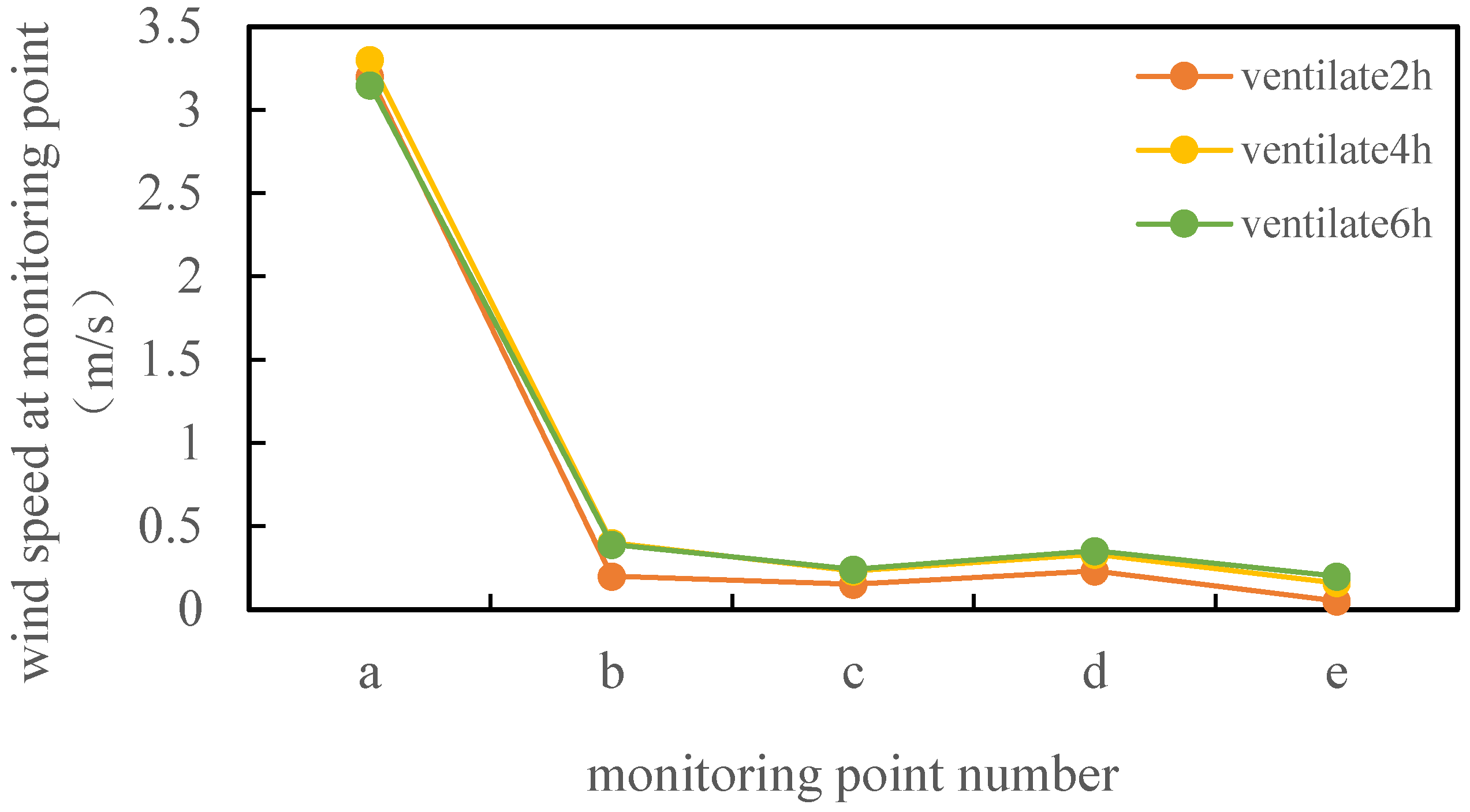

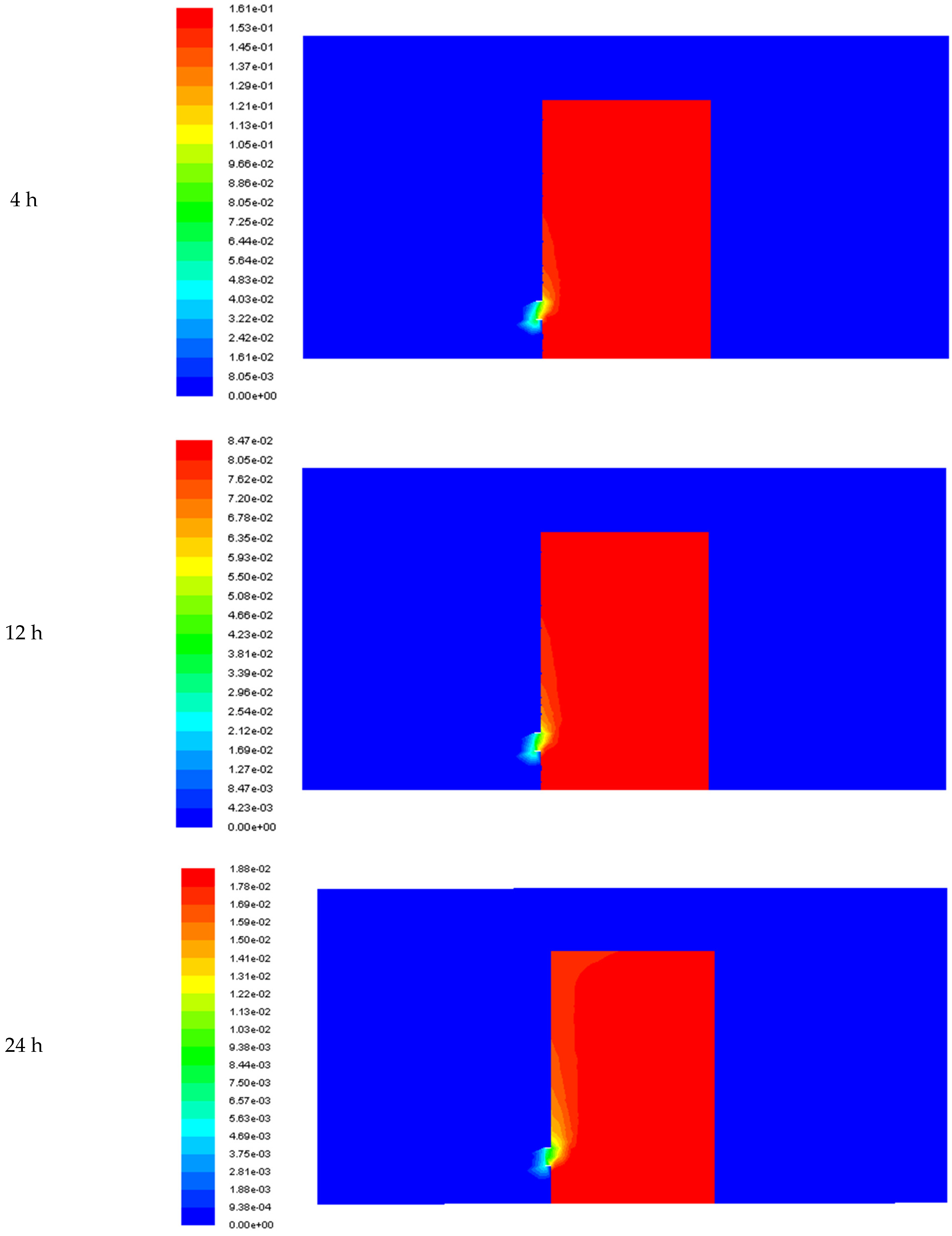
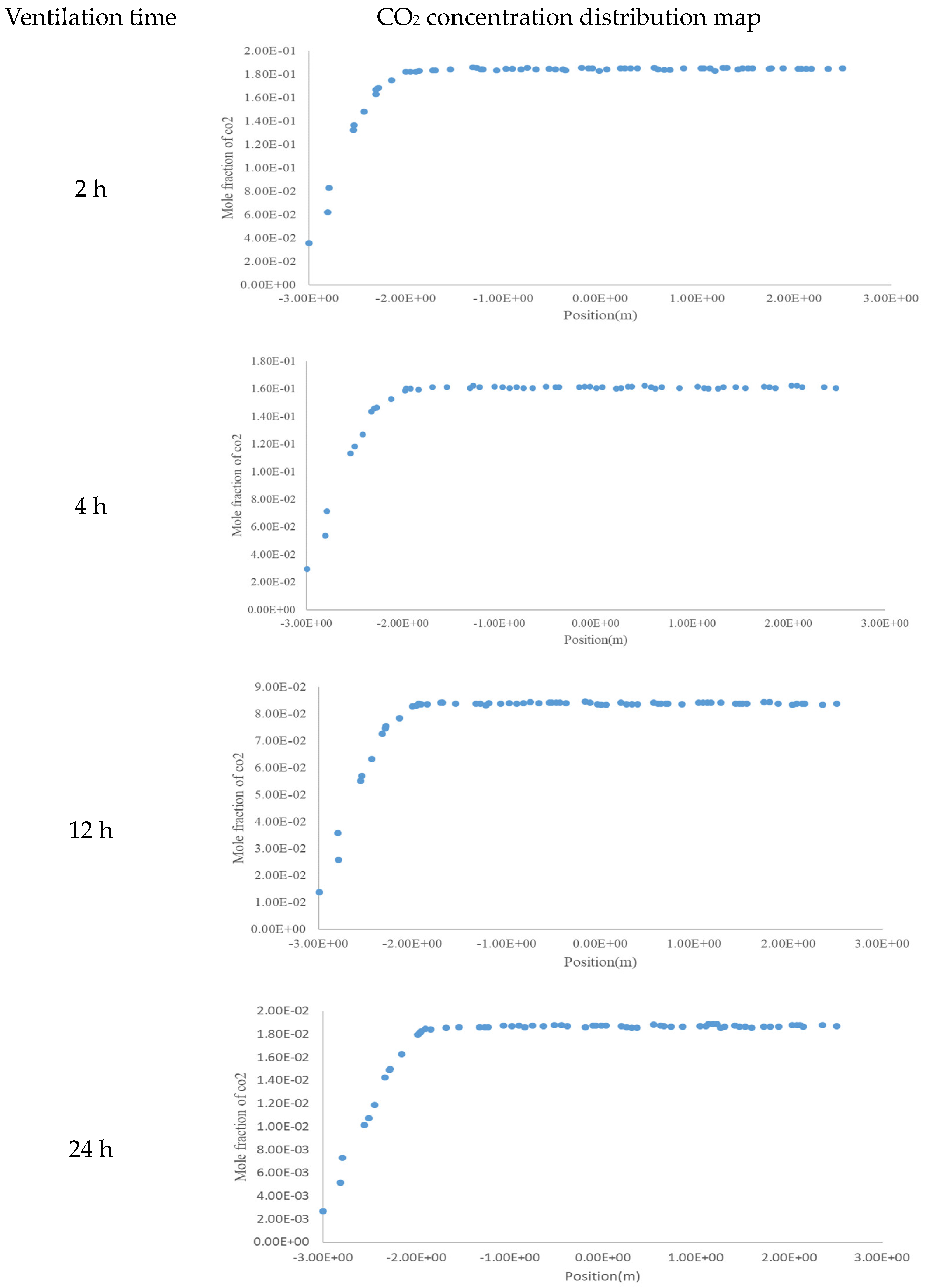


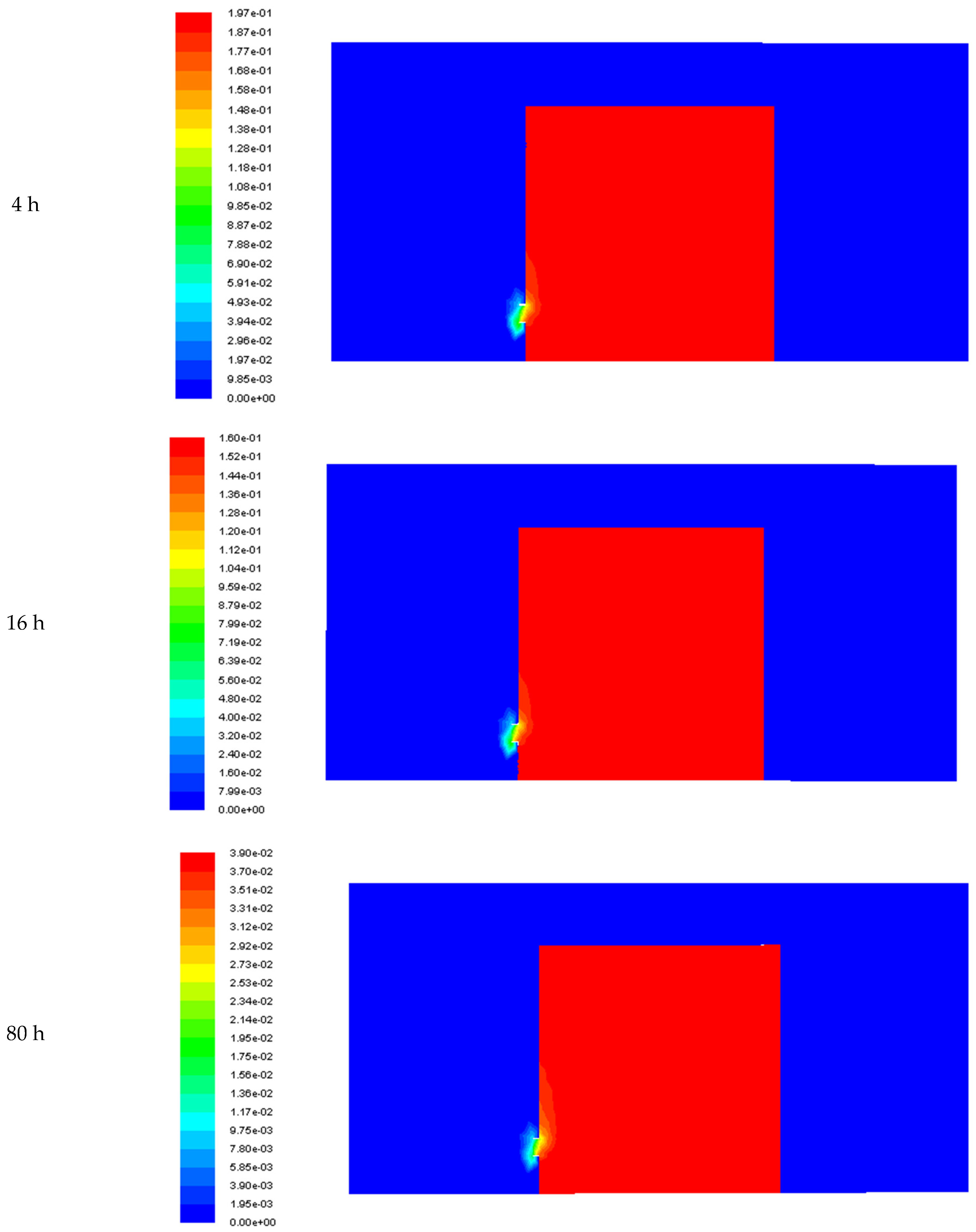
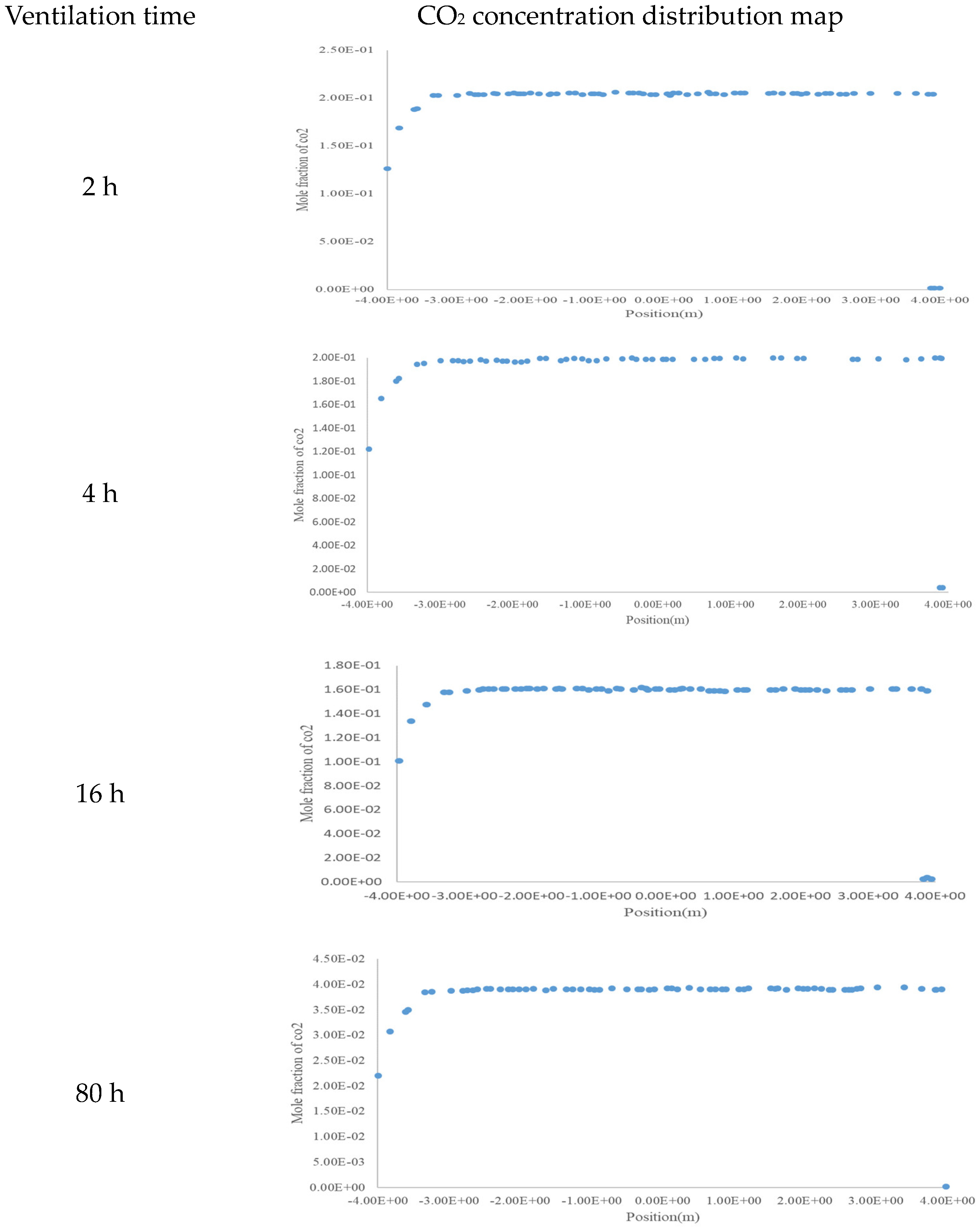



| Influencing Factors | Gas Tank Type | Tank Size | Number of Manholes | Manhole Location | Gas Composition | Ventilation Conditions |
|---|---|---|---|---|---|---|
| Different tank diameters | Vertical tank | Diameter 2.6 m; height 8 m | 1 | Side | CO2 (21%) and N2 (79%) [27] | Natural ventilation; horizontal wind (3 m/s) [28] |
| Diameter 5.2 m; height 8 m | ||||||
| Diameter 7.8 m; height 8 m |
| Model | Solver | Pressure Implicit Unsteady |
| Viscous Model | K-Epsilon | |
| Species | Species Transport | |
| Energy | On | |
| Boundary Conditions | Outlet Boundary Type | Outflow |
| Wall | No Slip | |
| Operating Conditions | Operating Pressure (Pascal) | 101,325 |
| Gravitational Acceleration | Z = −9.81 | |
| Solution Controls | Pressure–Velocity Coupling | SIMPLE |
| Pressure Discretization | Standard | |
| Discretization | First Order Upwind | |
| Convergence Criterion | 0.00001 | |
| Patch | Mass Fraction | 0.21 (CO2) and 0.79 (N2) |
Disclaimer/Publisher’s Note: The statements, opinions and data contained in all publications are solely those of the individual author(s) and contributor(s) and not of MDPI and/or the editor(s). MDPI and/or the editor(s) disclaim responsibility for any injury to people or property resulting from any ideas, methods, instructions or products referred to in the content. |
© 2023 by the authors. Licensee MDPI, Basel, Switzerland. This article is an open access article distributed under the terms and conditions of the Creative Commons Attribution (CC BY) license (https://creativecommons.org/licenses/by/4.0/).
Share and Cite
Yang, C.; Wang, Y.; Liu, Y.; Li, X. Simulation of the Gas Distribution Law and Operational Risk Analysis of a Vertical Gas Tank in a Ventilation State. Energies 2023, 16, 6855. https://doi.org/10.3390/en16196855
Yang C, Wang Y, Liu Y, Li X. Simulation of the Gas Distribution Law and Operational Risk Analysis of a Vertical Gas Tank in a Ventilation State. Energies. 2023; 16(19):6855. https://doi.org/10.3390/en16196855
Chicago/Turabian StyleYang, Chunli, Yinqing Wang, Yan Liu, and Xiangchun Li. 2023. "Simulation of the Gas Distribution Law and Operational Risk Analysis of a Vertical Gas Tank in a Ventilation State" Energies 16, no. 19: 6855. https://doi.org/10.3390/en16196855




